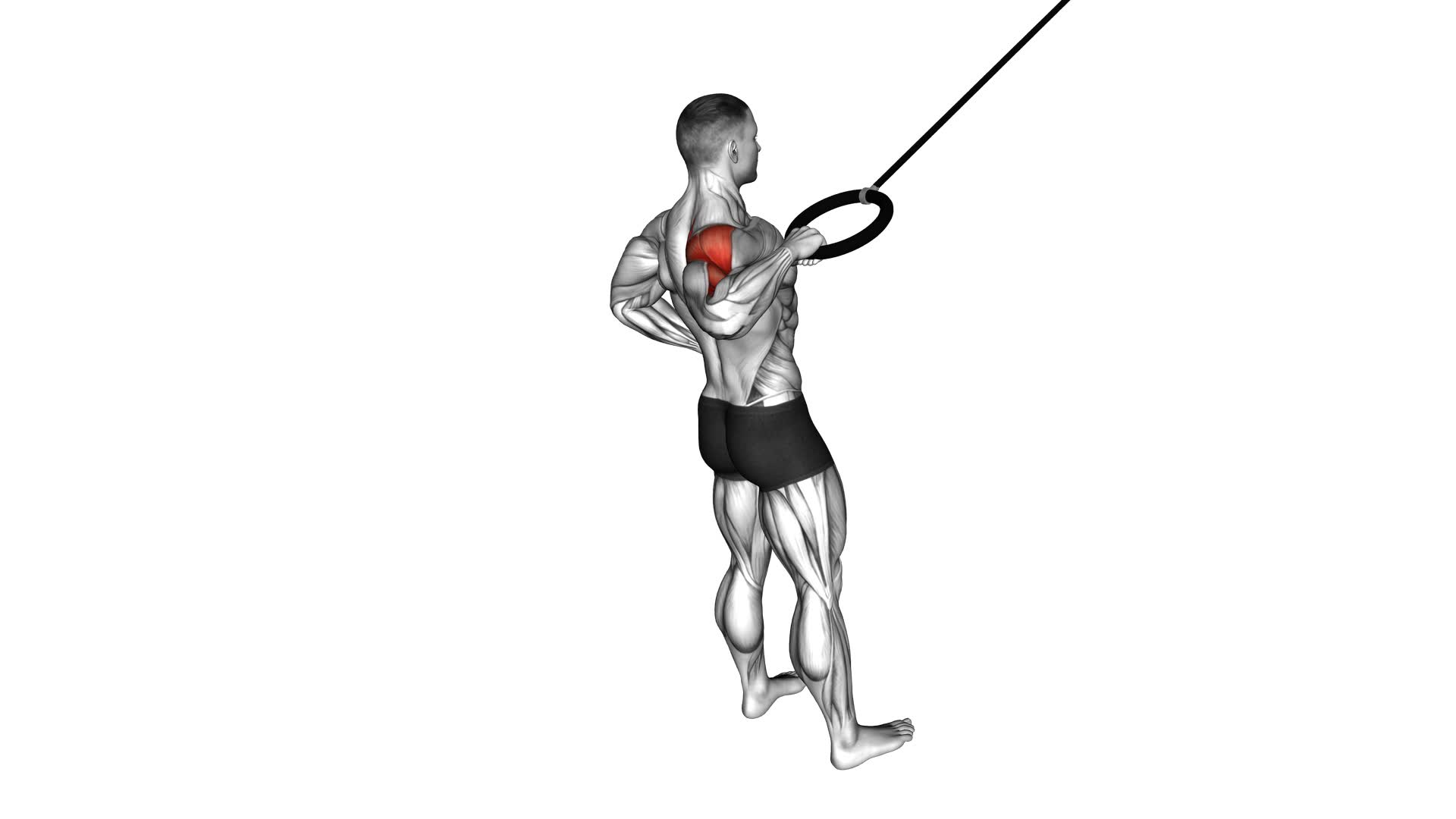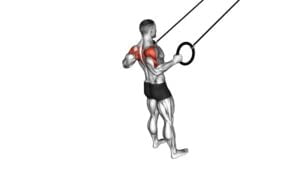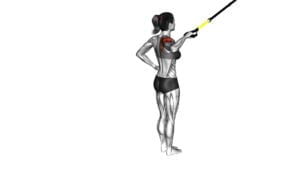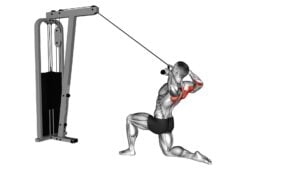Ring Single Arm Rear Delt Row (male) – Video Exercise Guide & Tips

Looking to strengthen your rear delts? Check out the Ring Single Arm Rear Delt Row!
Watch This Exercise Video
In this video exercise guide, you'll learn the proper form and technique, as well as variations and modifications to suit your fitness level.
Avoid common mistakes and maximize your results with helpful tips.
Get ready to target those muscles and take your workouts to the next level with this effective exercise.
Let's get started!
Key Takeaways
- Targets the rear deltoid muscles
- Improves posture
- Enhances shoulder mobility
- Contributes to a sculpted and defined back
Benefits of the Ring Single Arm Rear Delt Row
You will experience 5 key benefits from performing the Ring Single Arm Rear Delt Row. This exercise primarily targets the rear deltoid muscles, which are located at the back of your shoulders. Strengthening the rear deltoids is important for maintaining shoulder stability and overall upper body strength.
One of the main benefits of the Ring Single Arm Rear Delt Row is improved posture. By targeting the rear deltoids, this exercise helps to counteract the effects of slouching and rounded shoulders, which are common issues in today's sedentary lifestyle.
Additionally, this exercise helps to enhance shoulder mobility. Strong rear deltoids allow for a greater range of motion in the shoulders, which is crucial for performing various upper body movements and activities.
The Ring Single Arm Rear Delt Row also helps to prevent shoulder imbalances and injuries. By strengthening the rear deltoids, you can correct muscle imbalances and reduce the risk of shoulder impingements or rotator cuff injuries.
Furthermore, this exercise contributes to a more sculpted and defined back. The rear deltoids play a significant role in creating a well-rounded, muscular appearance in the upper body.
Lastly, the Ring Single Arm Rear Delt Row can improve overall upper body strength. Strong rear deltoids not only enhance shoulder stability but also contribute to a stronger and more powerful upper body.
Proper Form and Technique
To ensure proper form and technique for the Ring Single Arm Rear Delt Row, it's important to maintain a stable and engaged core throughout the exercise. This not only helps prevent injury but also maximizes the effectiveness of the exercise. Here are some key tips to help you achieve proper form and technique:
- Begin by standing tall with your feet shoulder-width apart and the ring securely attached at chest height.
- Grab the ring with one hand, keeping your arm extended and your palm facing inwards.
- Engage your core by pulling your belly button in towards your spine and maintaining a slight bend in your knees.
- As you row your arm back, focus on squeezing your shoulder blade towards your spine to activate your rear deltoid muscles.
- Remember to breathe steadily throughout the exercise, exhaling as you row your arm back and inhaling as you return to the starting position.
In addition to these form and technique tips, it's also important to prioritize stretching and muscle activation techniques before performing the Ring Single Arm Rear Delt Row. This helps prepare your muscles for the exercise and can improve overall performance. Incorporating dynamic stretches and foam rolling can help increase flexibility and range of motion, while using resistance bands or light weights for activation exercises can help activate your rear deltoids and warm up the surrounding muscles.
Variations and Modifications
For variations and modifications of the Ring Single Arm Rear Delt Row exercise, consider incorporating different grips and resistance levels. To add variety to your workout routine, you can try alternative exercises that target the same muscle groups.
One option is the Seated Rear Delt Fly, where you sit on a bench and use dumbbells to perform a similar pulling motion. Another alternative is the Bent Over Rear Delt Raise, where you bend forward at the waist and lift weights out to the side. These exercises can help you work your rear delts in a slightly different way.
When it comes to equipment options, you can use different types of resistance bands or cables to perform the Ring Single Arm Rear Delt Row. Resistance bands offer a portable and affordable option, allowing you to adjust the resistance level by using different bands or adjusting the tension. If you have access to a cable machine, you can use the cable attachment instead of the rings to perform the exercise. This can provide a smooth and controlled movement, allowing you to focus on engaging your rear delts effectively.
Common Mistakes to Avoid
When performing the Ring Single Arm Rear Delt Row exercise, it's important to avoid common mistakes that can hinder your progress and increase the risk of injury. To ensure proper form and maximize the effectiveness of this exercise, keep the following common mistakes in mind:
- Using too much weight: Avoid the temptation to lift heavier weights than you can handle. Start with a weight that allows you to maintain proper form and gradually increase as you build strength.
- Arching your back: Keep your back straight throughout the exercise to prevent strain on your lower back. Engage your core to maintain stability.
- Rounding your shoulders: Maintain good posture by keeping your shoulders down and back. Avoid hunching or rounding your shoulders forward, as this can put unnecessary stress on your neck and shoulders.
- Pulling with your biceps: Focus on engaging your rear deltoids, not your biceps, when performing the rowing motion. Keep your arm close to your body and squeeze your shoulder blades together.
- Neglecting the full range of motion: Make sure to fully extend your arm at the starting position and squeeze your shoulder blades together at the top. Avoid shortening the range of motion, as this can limit the effectiveness of the exercise.
Tips for Maximizing Results
To maximize your results, incorporate these tips into your Ring Single Arm Rear Delt Row exercise routine.
First, pay attention to your nutrition. Ensure that you're fueling your body with the right nutrients to support muscle growth and recovery. Focus on consuming a balanced diet that includes lean proteins, healthy fats, and complex carbohydrates. Additionally, stay hydrated before, during, and after your workouts to optimize performance and aid in recovery.
In addition to proper nutrition, implementing effective recovery strategies is crucial for maximizing your results. Make sure to prioritize rest days in your training schedule to allow your muscles to repair and rebuild. Incorporate stretching and foam rolling into your routine to improve flexibility and reduce muscle soreness.
Furthermore, getting enough sleep is essential for recovery and muscle growth. Aim for 7-9 hours of quality sleep each night to optimize your body's ability to repair and rebuild.
Lastly, listen to your body and make adjustments as needed. If you experience any pain or discomfort during the exercise, modify the movement or seek guidance from a qualified fitness professional.
Frequently Asked Questions
How Many Sets and Reps Should I Do for the Ring Single Arm Rear Delt Row Exercise?
For the ring single arm rear delt row exercise, the optimal training frequency depends on your goals and current fitness level. Generally, it's recommended to perform 2-4 sets of 8-12 reps per arm.
However, you can vary the sets and reps based on your individual needs and progress. To progress this exercise, you can increase the weight, use a resistance band, or try different variations like the double-arm rear delt row.
Make sure to maintain proper form and consult a fitness professional if needed.
Can the Ring Single Arm Rear Delt Row Be Performed Using Resistance Bands Instead of Rings?
When performing the ring single arm rear delt row, you might wonder if you can use resistance bands instead of rings. While the exercise is typically done with rings, resistance bands can also be used as a suitable alternative.
Both options provide similar benefits, such as improving shoulder strength and stability.
The choice between bands and rings depends on your personal preference and the equipment available to you.
Is It Necessary to Use a Specific Type of Grip for the Ring Single Arm Rear Delt Row?
To maximize the effectiveness of the ring single arm rear delt row, it's important to use different grip variations. By changing your grip, you can target different areas of your rear delts and increase muscle activation.
Experiment with neutral, overhand, and underhand grips to find what works best for you. Remember to maintain proper form and engage your core throughout the exercise.
With the right grip and technique, you'll be able to get the most out of this exercise.
What Muscles Are Targeted During the Ring Single Arm Rear Delt Row Exercise?
During the ring single arm rear delt row exercise, you target several muscles.
The main focus is on your rear deltoids, which are responsible for shoulder extension and horizontal abduction.
Additionally, this exercise engages your rhomboids, trapezius, and latissimus dorsi muscles, helping to improve posture and upper body strength.
The ring single arm rear delt row offers numerous benefits, such as increasing shoulder stability and promoting balanced muscle development.
Variations of this exercise can further challenge your muscles and add variety to your workout routine.
Can the Ring Single Arm Rear Delt Row Help Improve Posture?
The ring single arm rear delt row is a great exercise for improving posture. By incorporating ring exercises into your routine, you can strengthen your back and shoulders, which helps maintain proper alignment.
To progress the ring single arm rear delt row for even better posture, you can increase the weight or resistance, or perform more reps. Remember to maintain proper form and engage your core throughout the exercise for maximum benefit.
Conclusion
In conclusion, the ring single arm rear delt row is a highly effective exercise for targeting the rear deltoids.
By maintaining proper form and technique, you can maximize the benefits of this exercise and avoid common mistakes.
Additionally, incorporating variations and modifications can help you challenge your muscles and achieve better results.
Remember to stay consistent and follow these tips to ensure a successful workout and improve your overall strength and posture.

Author
Years ago, the spark of my life’s passion ignited in my mind the moment I stepped into the local gym for the first time. The inaugural bead of perspiration, the initial endeavor, the very first surge of endorphins, and a sense of pride that washed over me post-workout marked the beginning of my deep-seated interest in strength sports, fitness, and sports nutrition. This very curiosity blossomed rapidly into a profound fascination, propelling me to earn a Master’s degree in Physical Education from the Academy of Physical Education in Krakow, followed by a Sports Manager diploma from the Jagiellonian University. My journey of growth led me to gain more specialized qualifications, such as being a certified personal trainer with a focus on sports dietetics, a lifeguard, and an instructor for wellness and corrective gymnastics. Theoretical knowledge paired seamlessly with practical experience, reinforcing my belief that the transformation of individuals under my guidance was also a reflection of my personal growth. This belief holds true even today. Each day, I strive to push the boundaries and explore new realms. These realms gently elevate me to greater heights. The unique combination of passion for my field and the continuous quest for growth fuels my drive to break new ground.



